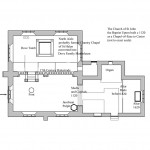DATA BASE REF: C/U 1009
 THE CHURCH OF
THE CHURCH OF
St JOHN THE BAPTIST
AT UPTON
Upton Church was built in 1120 AD as a Chapel-of-Ease to Castor Church. It became a separate parish in 1851, and in 1903 was united with Sutton. It is now part of the Benefice of Castor with Sutton and Upton with Marholm, and thereby retains its close historical links with Castor Church. Towards the end of the 12th century, a North Aisle was added. The capitals and responds of the Arcade from that date still remain, although the rest of the North Aisle was widened in the 1627, to include the stone steps, piers and balustrading and to make space for the Dove tomb.
The Dedication Name of the Church is a bit confusing. In 1521 a John Strete of Upton left his body to be buried at Castor, but made a bequest to the “Chapel of St Helen of Upton”. Either the dedication of the church was changed about the end of the 16th century, or within the church at Upton there was a side-chapel dedicated to St Helen, the mother of Emperor Constantine the Great.
The Dove Tomb. The tomb in the North Aisle is built of Barnack stone, the canopy being supported by 4 Ionic style pillars. On each side is a dove with an olive branch, symbol of the Dove family. Under the canopy is a figure of Sir William Dove (died 1633), between his two wives. His first wife, Frances Downhall lies on his right; his second, Dorothy Neville, lies on his left. The arms in the panels are as follows:
West Side – the Dove family
East Side – combination of Dove and Downhall, the first wife’s family.
South Side – joint arms of Dove and Neville, the second wife’s family (Note the ship, the Nevilles trace their ancestry from William the Conqueror’s admiral Neville)
The tomb and effigies are thought to be the work of Nicholas Stone, Master Mason to James 1st and Charles 1st .
The Chancel. The Altar table dates from 1620 AD, and the altar rails are probably earlier. The pulpit is early Jacobean. The Font, as it now is, is 17th century.
The Church plate includes a curious beaker-style chalice dated circa 1610
The curious Sundial, in the field south of the church dates from the time of Charles 1st.

